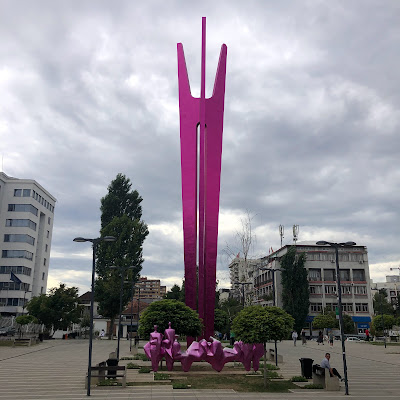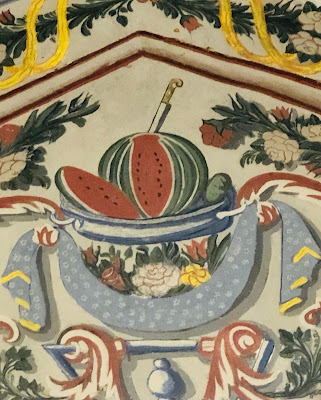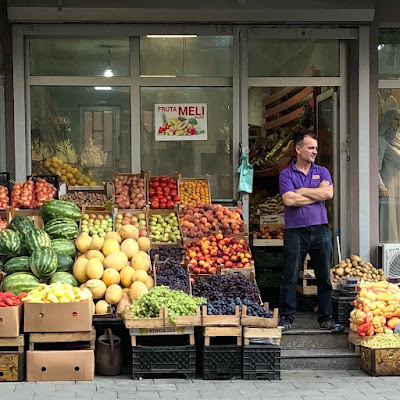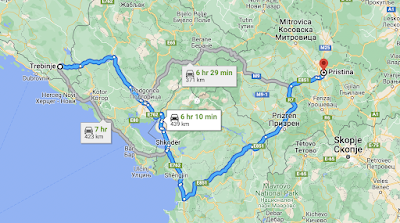In late August, my colleague and friend Annemarie DeWildt and I set off (see previous post) to Pristina, Kosovo to explore the art at Manifesta 14.
Manifesta, headquartered in Amsterdam, describes this year's event:
rethink[ing] the relation between culture and civic society, investigating and instigating positive social change through contemporary culture in response to, and in close dialogue with, the social sphere of the Host City and its communities. Manifesta has consistently chosen unexpected host locations that reflect Europe’s ever-changing DNA to shed light on a world defined by changing ethical and aesthetic imperatives. Manifesta, as a recurring event, has transformed itself into a multilayered and inclusive instrument of civic engagement projects. In 2022, Manifesta 14 Prishtina will take place in Prishtina, Kosovo. Manifesta 14 aims to support the citizens of Kosovo in their ambition to reclaim public space and to rewrite the future of their capital as an open-minded metropolis in the Balkans and in Europe through the development of a new cultural institution.
I had encountered bits and pieces of a previous Manifest, in 2014 in St. Petersburg, Russia, and needless to say, this was quite a different experience. Kosovo is a young country, having declared its independence from Serbia only in 2008, and is now formally recognized by more than a hundred countries, although not Serbia, Russia, or China. The wars of the Balkans, too complicated to explain in this blog post, shaped a great deal of what we saw in Pristina as it continues to echo into and shape the lives of Kosovans and others in the region.
The art was all over the city, and in just over two days, we visited as many places as possible, which helped us understand one goal of Manifesta, to "support the citizens of Kosovo in their ambition to reclaim public space." Ir's not a large city, and by walking everywhere, we got a sense of the city itself, encountering artworks and public spaces along the way, creating as it were, our own narrative of this place. For both of us, I think, we found the works that explored the complex past, present and future of the region most compelling and often found ourselves, as history museum people, talking about the many ways that the artists used narratives in their work--and sometimes wondering about who gets to use whose narratives and who tells what stories. My understanding of contemporary art is really that of an interested observer--so context, other artistic inspirations, movements and the like are absent for me.
Here's just a sampling of some of the works I'll long remember (and as I write this, so many others return to me--so please explore them all here).
Marta Popivoda's Yugoslavia, How Ideology Moved Our Collective Body looked at the ways in which Yugoslavia's collective body, as shown primarily in found footage of youth festivals, changed over time, from an idea of a collective solidarity, leading to the question she poses, "Why, did citizens so readily abandon the maxim of brotherhood and unity in favour of nationalism, individualism and capitalism? Was there, is there not something to be salvaged from socialism? " When my daughter was in middle-school, she came home one day having learned about Communism for the first time. "I don't get it, she said, "it seems like a good idea." Marta took that sense of a good idea and by brilliant editing and narrative, brought a sense of the collective body and of the possibilities, than then fell away. The narrative in this was both collective and intensely personal.
Artan Hajrullahu's beautiful small-scale works, done on brown packing paper, are the most personal of narratives, showing images of everyday life in detail that is both realistic and dream-like. They drew you into imagined lives, where you could both sense his story and create your own narratives.
I find myself often looking at hands and feet in portraits, and Alije Vokshi's work intrigued me. After becoming fascinated with a laborer's hands, she began putting those large hands, those hands, she says, as “a signifier of hard work and diligence.” She makes seen the unseen narratives of hard work done by many,
And of course, I have to mention a story that includes pickles! Fahrije Hoti and the Women of Krushë e Madhe is an incredible narrative, one not often seen in art exhibitions. 243 men and boys were taken from the village in 1999, now presumed killed by Serbian forces. Those devastating losses also had economic impact. In 2005, Hoti, along with other war widows, founded a company to sell ajvar and pickles, despite cultural prejudice against women in business The company now employs 50 women and their products can be found all over the country. I wanted to know more of the stories in the installation, but the inclusion alone in Manifesta told a particular narrative of feminism and resilience.
All of the above works were in the Grand Hotel, built in the 1970s and including, in an of itself, numerous narratives. Half of most of the floors were stripped back to the concrete and used for exhibitions, but in the other half, the hallways and rooms remained. We got a glimpse of Tito's restored apartment (both creepy and cheesy) there and learned about the art that had once been on its walls.
As we traveled around the city, we talked about often how these works, using narratives, can inform the work of history museums. Are we too concerned with only the factual truth? What is the role of emotions in our work? At the same time, can we do something that artists cannot?
Yesterday on Twitter I came across this from writer Hilary Mantel, as part of tributes to her unexpected passing that somehow helped me connect artists and historical narratives. In a 2017 Reith Lecture, she wrote:
Evidence is always partial. Facts are not truth, though they are part of it – information is not knowledge. And history is not the past – it is the method we have evolved of organising our ignorance of the past. It’s the record of what’s left on the record. It’s the plan of the positions taken, when we to stop the dance to note them down. It’s what’s left in the sieve when the centuries have run through it – a few stones, scraps of writing, scraps of cloth. It is no more “the past” than a birth certificate is a birth, or a script is a performance, or a map is a journey. It is the multiplication of the evidence of fallible and biased witnesses, combined with incomplete accounts of actions not fully understood by the people who performed them. It’s no more than the best we can do, and often it falls short of that.
In Pristina, many artists turned those scraps of history, personal and collective into something new, and for me, helped turn history from just a map, just a scrap, into a journey. Here's just some other bits and pieces (I notice that I am also attracted to artwork that uses text!)

























